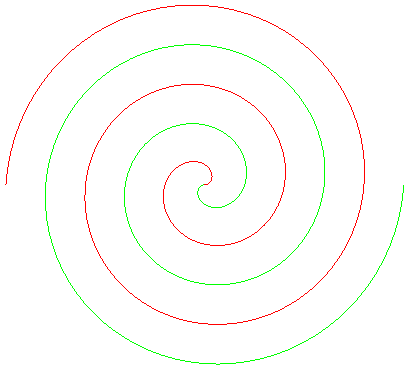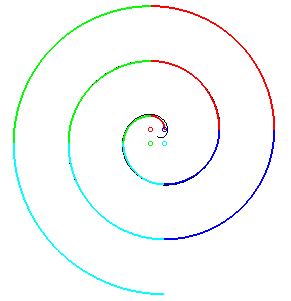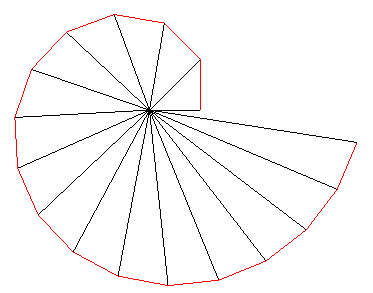ARCHIMEDEAN SPIRAL

| next curve | previous curve | 2D curves | 3D curves | surfaces | fractals | polyhedra |
ARCHIMEDEAN SPIRAL

| Discovery of the curve attributed to
Conon
of Samos, disciple of Archimedes; modern study by Sacchi in 1854.
Archimedes of Syracuse (287-212 av. J.C.): Greek savant. Other names: equilateral spiral, neoid. Link to an animation of the compressor with spiral. |
 |
For a spiral with path Polar equation: Transcendental curve. Caracterisation: Arc length: Radius of curvature: Length of the n-th spire obtained for
|
 |
For example, "The surface of the first round of the spiral is equal to one third of the surface of the circle of which the radius is the length traveled by the point on the straight line during the first round". |
The Archimedean spiral is the trajectory of a point moving uniformly on a straight line of a plane, this line turning itself uniformly around one of its points (carried out for example by the groove of a good old vinyl disk); here, O is the center of rotation, r = 0 for q = 0.

Now, notice the difference with the
logarithmic
spiral.
For example, a person on a turntable rotating at a constant
speed and traveling at a constant speed towards the center, describes,
in the fixed reference frame, an Archimedean spiral (see the curve
of the swimmer and see also the circle
involute for the case where the person does not go towards the center).
 |
 |
 |
| Once it is not customary, the complete spiral |
...that does not, and shares the plan in two
connected, symmetric with respect to O, regions (cf. the spiral of Fermat). |
This is how this string was coiled. |
| Remark: any conchoid
of this spiral, of equation |
 |
 Heart-shaped cam, formed of two branches of Archimedean spirals: the rotation movement is transformed into the succession of two straight rectilinear movements of opposite directions. |

On the right of the sewing machine is the heart-shaped cam. |
| Other application: if a stick of length 2a is forced to slide at the top of an Archimedean spiral, and its middle is forced to pass through the central loop of this spiral, the ends describe the previous heart-shaped cam. |
 |
| Chasles' Theorem: the Archimedean spiral is the roulette
obtained by rolling a line on a circle with center O and radius
a
and taking a tracer point located at a distance to that line equal to the
radius of the circle. The projected point of this tracer point on the line
tracing a circle
involute, we deduce that the Archimedean spiral is also the pedal
curve of the circle involute.
This circle involute, which is therefore very simply constructed by rolling a straight line on a circle, is in fact a simple means of constructing the Archimedean spiral in an aproached fashion. |
 |
As well as the golden
spiral for the logarithmic spiral, the Archimedean spiral possesses
approached constructions by arcs of a circle, as the spiral with 4 centers
opposite (arcs of a circle are colored with the same color as the corresponding
centers); this construction becomes widespread with any
number of centers.
|
 |
| The Theodorus (of Cyrene)'s said spiral, or snail
of Pythagoras (in german, Quadratwurzelschnecke), provides an approached
construction by right segments of an Archimedean spiral.
The construction of the  that The Theodorus spiral is then asymptotic to the Archimedean spiral |
 |
 |
The Archimedean spiral can also be defined as a curve with constant polar subnormal.
Finally, it is the (orthogonal) projection of the conic spiral of Pappus on a plane orthogonal to the axis of the cone.

- a quadratrix:
if A is the point of polar angle
and B the point of intersection of the tangent in A with
Oy,
OB
/ OA =
.
- a trisectrix
and even a
n-sectrix :
if a line of polar angle
cuts it at
,
the circle with center O and a radius of
cuts it in
.

See at wheel-road couple the rolling of an Archimedean spiral on a parabola.
See also the conical spiral of Pappus, the conical analogue of the Archimedean spiral, the clelie, its spherical analogue, the Doppler spiral, the constant angular acceleration curve.
Any sequence of points of the complex plane whose modulus and amplitude are in arithmetical progression describes an Archimedean spiral.
For example, in the figure below, for n = 30, the
points of polar coordinates
have been plotted, in blue if l is even, in red otherwise; these
points are staggered at the intersection of concentric circles of radii
in arithmetic progression and concurrent lines; but they are also located
on the Archimedean spirals of equation
,
hence a nice effect.

 
Spiral mosaics from Guy Barthélémy |
|










| next curve | previous curve | 2D curves | 3D curves | surfaces | fractals | polyhedra |
© Robert FERRÉOL 2024